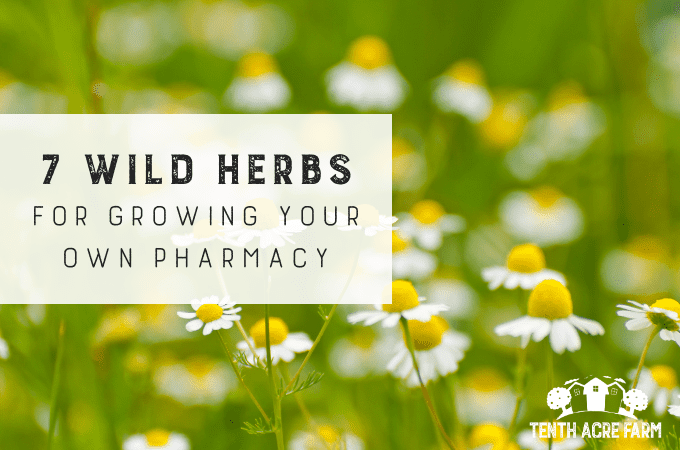7 Wild Herbs for Growing Your Own Pharmacy
Wild herbs have long been known for their medicinal value. Learn about a number of wild herbs to grow in your garden to have your own free pharmacy.


This page may contain affiliate links. Please read my disclosure for more info.
Grow Your Own Free Pharmacy
Many herbs are known as potent sources of nutrition and healing. I love growing herbs in my medicine garden as well as my food forest. But I’m also thrilled and comforted to have wild herbs growing voluntarily around the garden.
How cool is that to have a wild, free pharmacy?
Wild herbs can also repair soil and attract beneficial insects. I enjoy selecting those herbs that are multifunctional—healing to both humans and ecosystems—for my permaculture garden.
7 Wild Herbs To Grow In Your Backyard Pharmacy
The following are some of my favorites that I allow to grow and prosper around the garden.
1: German Chamomile (Matricaria chamomilla or Matricaria recutita): The wild herb known as “The Plant’s Physician”
This dainty, cute-as-a-button, flowering herb is an excellent tea with calming properties that is child-friendly. It supports gastric relief and is anti-anxiety.
Chamomile thrives easily in the garden, while attracting pollinators and beneficial insects. This is why I like to grow chamomile in the vegetable garden.
However, it has been called “the plant’s physician” because it supports and appears to heal surrounding plants, which is why I like to grow it under my fruit trees.
Here are the chamomile seeds I buy.
2: Chickweed (Stellaria media)
This wild herb is often considered a weed because it shows up in disturbed areas, but that just makes it more valuable as a pharmacy plant. It aids in healing of all tissues, especially the skin and lungs. Chickweed has anti-inflammatory properties, as well.
Consider making a healing chickweed tincture for all manner of internal and external ailments.
The prolific, mineral-rich greens can be added to salads or juices, and they make a rich green mulch in the garden.
This herb typically shows up voluntarily in my garden, but it can also be sown into an empty spot. Here is a good source for chickweed seeds. It will become a thick green carpet very quickly, with all the green matter you need for medicinal purposes, mulching, and composting.
Tired of generic permaculture design advice that you can’t apply to your specific goals? If so, check out my Permaculture Design Program and get the tools and support needed to create and implement your own permaculture design.
3: Chicory (Cichorium intybus): The wild herb known as a digestive aid and coffee substitute
You’ll often see chicory’s purple flowers lining the roadsides. They’re usually among the first wild herbs to spring up in those disturbed corridors. I wouldn’t recommend harvesting from the roadside, but if you happen to have chicory popping up in a wild area of your yard, take heart.
As an herb for healing human ailments, it has a long list of benefits. Make the roots into a tea to aid in digestion and detoxification.
Chicory is an excellent coffee substitute with a hazelnut-like taste.
This herb is also helpful for healing soil. Its roots are on my list of clay-busting plants for food forests. You can also chop and drop it regularly to allow its green matter to enrich the soil.
Here’s more about foraging for chicory and here are the seeds I bought.


chicory flower
4: Stinging Nettle (Urtica dioica)
Many people curse the “sting” caused by touching the tiny hairs on the stems. It certainly isn’t pleasant to come across unexpectedly, but growing nettle in a dedicated part of the garden can be a real boon for your homegrown pharmacy.
One of the most nutrient dense plants that we know of, nettle is super-rich in vitamin C. Try using it to make your own tonics, teas, and tinctures for healing various ailments. Consider making a healing stinging nettle-ade.
Add it to a salve to help relieve joint pain. See my article How to Make Herbal Salve.
Wear rose pruning gloves when harvesting this herb to avoid the “sting”. Eat the leaves like spinach—there’s no sting when you steam them first.
Nettle helps to heal soil and activate soil ecology. Here is a good source for stinging nettle seeds.
If you’d like to learn how to forage for stinging nettle and other herbs, here’s a course I recommend.
5: Broadleaf Plantain (Plantago major): The wild herb known as “White Man’s Foot”
Plantain received its nickname during colonial times, when it began popping up where settlers had created footpaths and other heavily traveled areas that developed compacted soil.
Plantain is especially known for its wound healing and anti-inflammatory properties, which makes it an excellent candidate for a healing herbal drawing salve.
Its fibrous roots break up and enrich compacted soils, so it helps me make the case that sometimes weeds are good.
Here’s more about foraging for plantain.
6: Purslane (Portulaca oleracea)
Purslane is a common garden weed that’s easy to pull up in areas where you don’t want it.
But before you give it the old heave-ho, you may want to reconsider. A bit of crushed purslane can help to sooth insect bites or stings.
This wild herb is as nutritious as watercress or spinach. You can eat the stems and leaves raw in a salad, cook it down like you would spinach, or make a pesto out of it.
Here is a good source for purslane seeds.


Fresh purslane
7: Yarrow (Achillea millefolium): The wild herb known to stop bleeding
This beautiful flower with lacy foliage is a prolific grower and includes a number of accolades for medicinal uses, healing soil, and increasing biodiversity.
Whether it is used as an anti-inflammatory, to stop bleeding, or as a general first aid remedy, yarrow is well known as an effective, medicinal wild herb.
No less are its attributes in contributing to rich fruit tree guilds and other permaculture endeavors.
I hope you’ll consider allowing some of these useful wild herbs to grow freely in your garden so that you’ll always have a free pharmacy at your disposal.
Here is a good source for yarrow seeds.
What wild herbs are growing in your backyard pharmacy?
READ NEXT:








